
|
Sale 31
Pre-Long Beach Coin Auction
| Lot |
Photo |
Description |
Realized |
Lot 2154 |
 |
Great Britain. Unite (20 Shillings), ND. S.2692; Fr-246. Charles I, 1625-1649. Tower Mint under the King. Mintmark, plume. Crowned bust left, numerals for value behind. Reverse: Crowned shield. As struck, mint state example. Excellent portrait of King. Original mint luster. This excellent piece came from on of the most famed collections of fine English hammered coins and is worthy of a place in any top quality collection. NGC graded MS-62.
Estimated Value $4,500 - 5,500.
The Cheshire Collection.
View details and enlarged photos
| Realized
$10,500 |
Lot 2155 |
 |
Great Britain. Gold Crown, ND. S.2707; Fr-248. Charles I, 1625-1649. Tower Mint under the King. Mintmark, star. Crowned bust left, numerals for value behind. Reverse: Crowned shield. As struck, superb portrait. NGC graded MS-62.
Estimated Value $1,000 - 1,250.
The Cheshire Collection.
View details and enlarged photos
| Realized
$2,300 |
Lot 2156 |
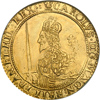 |
Great Britain. gold Triple Unite, 1643. S.2727; Fr-258. Charles I, 1625-49. Oxford mint. Crisply struck in most portions of both sides, with an excellent portrait of the king. This is a virtually mint state example of a coin which had a value of 60 shillings. Variety without scarf flowing from the monarch's neck, but with a longer olive branch draped over his shoulder. The largest gold coin ever struck in England, made inside the old castle at Oxford. These are products, really, of and for the king's use during the Civil War, and half a dozen varieties exist of the pieces minted from 1642-44 (although the mint itself continued to function until 1646). Generally speaking, the king's portrait on these coins is perhaps more lifelike, and elegant, than on any of his other currency coins. The coin is rife with symbolism, from the sword held out in defiance by the king to the wavy banner of the reverse side, on which is scrolled the famous Latin abbreviation of "declaration," which admitted the powers of "the religion of the Protestants, the laws of England, and the liberty of Parliament" (as it translates) but nonetheless insisted, by its very existence, on the sovereignty of the king. This was an era of great impending change, when people all over Europe spoke through their landlords in objection to kings' divine right to rule. But Charles I seemed oblivious of this coming wave, going so far as to place a statement on his divine right on the reverses of many of his coins in the Latin legend "Christo Auspice Regno" -- literally, "I rule with Christ's approval." When he pinched his subjects with one tax too many, trouble began. His declaration, engraved on the reverse of this massive gold piece, was the essence of his objection to Parliament's interference in his divine right, "declared" to the Privy Council on September 19, 1642, at Wellington. It prodded Oliver Cromwell to chase Charles and his army from city to city, and made Charles literally a king with an army but without a kingdom, until he fortified himself inside the walls of medieval Oxford. Eventually starved into surrendering, he met his fate in 1649, as everyone knows. When the Commonwealth played out its short part in history, and the king's son returned from exile in 1660, as Charles II, the sovereigns of England would never again enjoy the powers they traditionally held. None would ever really "go to war" again as kings had done for centuries, but instead they became titular heads of state, rubber-stamping the laws created by Parliament. This coin is a marvelous example--gleaming with subtle luster and possessing an excellent portrait of King Charles, and particularly pleasing surfaces--of this famous transition of power, and a true work of Renaissance art as well. NGC graded AU-58.
Estimated Value $28,000 - 33,000.
The Cheshire Collection.
View details and enlarged photos
| Realized
$27,600 |
Lot 2157 |
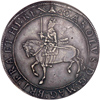 |
Great Britain. Horseman silver Crown (1634-35). Charles I (1625-49). S-2758. Struck during the period known as "Tower mint under the king," meaning prior to the outbreak of the Civil War. Bell mintmark (as used 1634-35). This is a silver classic, the king as warrior horseman, holding a raised sword. And this specimen is a gem of a coin! As fine as the Spink plate coin (page 262, 2005 edition), in fact sharper in some areas, with the two bell mintmarks round and bold. NGC graded EF45, and it is indeed a Choice Extremely Fine example, a graced by ages-old, well-set dark-gray toning. For a large coin of its era, it is also remarkably free from marks. A perfect example of this coinage, which is why the owner of the Cheshire Collection selected it to represent this coinage style. NGC graded EF-45.
Estimated Value $5,500 - 6,500.
The Cheshire Collection.
View details and enlarged photos
| Realized
$11,500 |
Lot 2158 |
 |
Great Britain. Charles I (1625-49) silver Shilling (1635-36). S-2787. Tower Mint issue, under the King (1625-42). Crown mm (struck 1635-36). Garnished oval shield. Most silver of this era is wretched in strike on ill-shaped, horrid metal. However, this coin, for the issue, is well struck overall, showing most details clearly. Medium gray toning. Porous fields but handsome bluish gray toning. What is also special about this coin is its almost fully round, uncracked flan. This type is exceedingly difficult to find in a grade such as this; just compare the Spink plate coin, presumably the nicest illustration that could be found: the current lot compares very favorably to that, and might possibly be slightly finer. The portrait, while crude, is particularly appealing and well preserved. NGC graded AU-50.
Estimated Value $500 - 600.
The Cheshire Collection.
View details and enlarged photos
| Realized
$552 |
Lot 2159 |
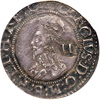 |
Great Britain. Charles I (1625-49) silver Half Groat. S-2818. Triangle mm (struck 1639-40). In contrast to the Briot pattern, here the portrait is less refined and faces to the left. A remarkably fine coin, dark gray in color, overall well struck, and showing only the slightest real wear. For the issue, exceptional! It must have been difficult to strike by hand these thin, very light coins, which so easily must have flip-flopped out of the collarless dies. Most perished in the Great Recoinage of 1697, and this survivor is a minor wonder of its age. NGC graded AU-55.
Estimated Value $150 - 200.
The Cheshire Collection.
View details and enlarged photos
| Realized
$230 |
Lot 2160 |
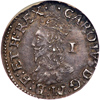 |
Great Britain. Charles I (1625-49) silver Penny. S-2835. Tower Mint issued under the King, circa 1625-42. Not always distinct, this appears to be N-2272, with the Aberystwyth bust. No inner circle on obverse but two dramatically raised pellets, and the "1" for One Penny behind the king's head. Insightly graded by NGC: no evident wear, remnants of luster beneath deeply set dark gray patina showing gold iridescence in the shield. This coin is so unusually well preserved and struck that it reminds the cataloguer of the extremely rare Proof shilling of this era. The owner of the Cheshire Collection was impressed by the roundness of this coin, and noted to us that "it may be a specially produced item or presentation piece." NGC graded AU-58.
Estimated Value $250 - 300.
The Cheshire Collection.
View details and enlarged photos
| Realized
$334 |
Lot 2161 |
 |
Great Britain. Charles I (1625-49) silver Shilling (1643-44). S-2843. Tower Mint issue, under Parliament (1642-48). "P" in brackets mm (Spink #98, struck 1643-44). Extremely elusive variety, the first time this cataloguer has ever seen this peculiar mintmark on a superior coin! The standard catalogue describes this issue as "coarse work" and that is clearly an understatement, for the die-work here is almost comical. The reason, of course, is that the talent escaped London with the king at almost the same moment this very coin was struck. The king was under threat of life and Crown even at the outset of the Civil War, when this coin was minted. He was as yet not disowned as Monarch, however, and the weak Parliament which preceded Cromwell's rise to overlordship was the official issuer of this coin, or "in the king's name" as the saying went. If you understand this groundwork, this historical context, you must perforce be impressed by this extraordinary specimen! NGC graded MS62 but the cataloguer is at a loss to explain the number. The coin is clearly Choice and without wear, peering at it under magnification. The surfaces are original and elegantly toned a medium gray color. While crudely cut, the portrait is extraordinary, suggestive of the strife of its day; the king's bodice shows some fascinating little details, vague emblems of majesty. The shield is equally interesting and well struck. So too the legends, although they are only partial, some letters being off-flan because of its shape. The rarely seen mintmark is crisp in detail. At first glance this coin looks like nothing, a crude cobbling of elements. The more you study it, though, the more you realize it's a simply superb example of this emergency coinage, made at one of England's most horrific moments, outbreak of its disastrous Civil War, which when it ended in 1660 brought back a monarchy totally different in power and attitude from that which prevailed in 1643, when this coin was made, almost even then "in memory" of once-mighty kingship. NGC graded MS-62.
Estimated Value $600 - 800.
The Cheshire Collection.
View details and enlarged photos
| Realized
$1,208 |
Lot 2162 |
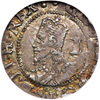 |
Great Britain. Charles I (1625-49) silver Penny. S-2851. Tower Mint, struck under the authority of Parliament, circa 1642-48, at the outbreak of Civil War. A variant on the "specimen" piece offered here (S-2835), part of the Cheshire Collection to show the more normal style and quality of pennies of this period. This piece, too, however, is exceptional, but it is more normal in execution. Light gray toning with some golden hues. Very pleasing; indeed, one of the finest to be found! NGC graded AU-55.
Estimated Value $150 - 200.
The Cheshire Collection.
View details and enlarged photos
| Realized
$196 |
Lot 2163 |
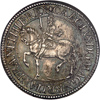 |
Great Britain. Halfcrown, ND. Charles I, 1st milled issue, by Nicholas Briot. S-2853. First issue, with flower and "BB" initial marks, the king equestrian facing the left. Nicholas Briot produced two issues, this the first in 1631-32, and another with anchor and single "B" initial mark a few years later, in 1638-39. Sutherland comments that King Charles, who had a strong personal interest in art, found himself repulsed by the coinage portraits produced for his father by the mint's chief engraver, Edward Greene, and in consequence summoned Abraham Vanderdort of Holland to attempt a better engraving of himself. Vanderdort was skilled in wax-modeling, and was also advisor to the Crown on objets d'art. He quickly produced some portraits of "slender elegance and dignity," but Charles wanted even more, for "Vanderdort's designs were still at the mercy of the technical shortcomings of the mint engravers." Charles found what he needed in the person of Nicholas Briot, engraver-general at the Paris mint who had also developed a new machinery for producing coins. He came to England in 1625 and fashioned a series of portraits for the king ranging from medals to many denominations of coins made by hammer. He also engraved the new Great Seal of England. In 1629 the king granted him authority to set up his machinery, and the result was the splendid coinage represented by the exquisite coin in this lot (as well as the magnificent Tower gold Unites of the same period). He fell into one of the most embroiled moments in English history, the Civil War of the 1640s, clandestinely worked for the king on the run, and "controlled the artistic scene" of his era. Despite the fact that he engraved at the same time as another master, Thomas Rawlins, he remains at the top of the list of most-skilled engravers who produced coins in England through many centuries. Add to this list Thomas Simon, who worked a few years later on, and it must be clear that the 1640s and 1650s in England were a time of outstanding numismatic artistry. Previously graded MS62 by PCGS, now given the "Cheshire" registry as well by NGC, this coin is virtually as made and graced by a lovely, ages-set medium gray and blue toning, with hints of golden iridescence. It enjoys "perfect" original eye-appeal. A few tiny spots are not fully struck, but overall the details are extraordinarily well impressed by the roller-dies. The Cheshire collector notes that this coin is the finest he ever saw, which is why he bought it from the Terner sale (for $8,912). Dr Terner owned the coin for years, and previously it had been purchased from Richard Lobel about 1980. NGC graded MS-62.
Estimated Value $7,500 - 9,000.
The Cheshire Collection.
View details and enlarged photos
| Realized
$6,038 |
Lot 2164 |
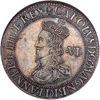 |
Great Britain. Silver Briot Sixpence (1631-32). Charles I. S-2855. Nicholas Briot, another French import to the Royal Mint, evidently was not put off by Mestrelle's misfortune working for the Crown under Elizabeth. Or possibly he did not know of the earlier experiment in machine-made coinage. His own work was clearly a departure from the sad state of affairs of a typical working day at the Mint. The coinage was ragged, and most of the engraving disgraceful. Blanks were poorly prepared, split and broken and always oddly shaped. At some point the mint wardens had had enough, and called upon Briot to try his hand. This he did twice, the first time for this First Issue of 1631-32, where he marked his dies with a tiny capital "B" and a flower which resembles a sun's face. The second effort produced, instead, an anchor and "B and appeared 1638-39. The later coins in particular tend to exist with lots of adjustments across their faces, as well as partially weak in strike, evidence that the minting equipment was not perfected, advanced as it was against the hammered-die process. Once again, the hammerers, surely jealous of the new coins, forced the Frenchman from his post, and they continued in their employment, even through the Civil War, for another two decades, when experiments like Briot's finally led to new, satisfactory, and fast minting machinery. Thus coins like this one are from the end of an era, pointing to the next. Here is one of the prettiest examples to be found, with handsome gray toning, very clean surfaces, and the bold appearance that was Nicholas Briot's goal. NGC graded MS-63.
Estimated Value $1,750 - 2,000.
The Cheshire Collection.
View details and enlarged photos
| Realized
$3,360 |
Lot 2165 |
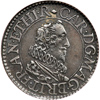 |
Great Britain. Charles I (1625-49) silver Pattern Half Groat. S-2856A. N-2687. Also known in copper, but here is a very pleasant example in silver. Two-tone light and medium gray, surfaces especially nice, just a little wear. The distinctive "B" for the designer, Nicholas Briot, appears beneath the classic interlocked Cs on reverse. Best feature of this charming coin is the delightful portrait of the king in his neck ruff, a peculiar fashion of his day. NGC graded AU-55.
Estimated Value $550 - 650.
The Cheshire Collection.
View details and enlarged photos
| Realized
$432 |
Lot 2166 |
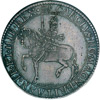 |
Great Britain. Briot Halfcrown (1638-39). Charles I. 2nd Milled issue. S-2858. Anchor and "B" mintmark on each side. King on horseback. A gleaming, Mint State example of the famous roller-dies produced early experiment in machine-made coinage by Nicholas Briot. This wonderful coin possesses somewhat prooflike fields and is darkly toned in rich silver-gray, with some iridescent highlights. The extraordinary obverse is fully struck, while the shield shows some softness of strike in the top two quadrants (but this is typical). The flans, or planchets, for these tend to show some porosity but this coin has little of that, and its overall impression is stunning! Not quite so fine as the example in our Terner 2 auction a year ago (which in the cataloguer's opinion was undergraded by PCGS at least two points), but no other specimen examined by this writer has equaled the present coin. Extremely rare in this outstanding state of preservation. This coin is so fine that an estimate of its value is difficult; Spink does not price it over VF grade (about $1600). The magnificent example in our Terner 2 sale (lot 1925) realized an astonishing $12,650 but was doubtless the finest known example. This coin has a similar eye-appeal and is distinctly Mint State, and seems to be second in line in terms of quality for the type, which is both elegant and highly historical, so we believe our estimate to be realistic. NGC graded MS-63.
Estimated Value $7,000 - 7,500.
The Cheshire Collection.
View details and enlarged photos
| Realized
$8,050 |
Lot 2167 |
 |
Great Britain. 6 Pence, 1643. S.2981. Charles I, 1625-49. Oxford mint. With Three Shrewsbury plumes and declaration in three lines. About Good, reverse Fine.
Estimated Value $200 - 250.
View details and enlarged photos
| Realized
$230 |
Lot 2168 |
 |
Great Britain. Ninepence, 1646. S.3144. Charles I. Siege coinage of Newark. Large crown between CR, value below. Reverse: OBS/NEWARK/1646. Practically as struck. Attractive dark tone. Rare this nice. NGC graded AU-58.
Estimated Value $4,000 - 5,000.
The Cheshire Collection.
View details and enlarged photos
| Realized
$4,600 |
Lot 2169 |
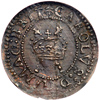 |
Great Britain. Copper "Royal Farthing" (1625-49). Charles I. S-3189. Mintmark bell on obverse (struck 1634-35). These earliest of coppers, which first appeared in the previous reign, are really tentative efforts by the mint to produce small change for the masses of citizens. Wretched is what most of them are today, ugly and blackish gray, bent and damaged, full of bronze diseases. That's the norm. Here, however, is a most happy exception, which NGC claims is Mint State for its sharpness, and it most probably is, but traditional collectors of these would probably label it "Good EF" and would be thrilled to find it! Wear or its absence is axiomatic in such coins as these, where rarity rules. The obverse shows a small, light scratch revealing bright copper. NGC graded MS-62 Brown.
Estimated Value $100 - 150.
The Cheshire Collection.
View details and enlarged photos
| Realized
$173 |
Lot 2170 |
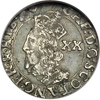 |
Great Britain. Charles I, 20 pence, 1625. Charles I. S-5581. Struck from worn dies. Metal somewhat porous. Portrait, reverse thistle, and almost all details quite sharp, better than normally seen in a Scots piece like this! Light gray toning. Mintage unknown, for as I.H. Stewart says these were minted by the "stone." Scottish coins circulated broadly in the land with few saved as collectibles, so the precious high-grade survivors are rare. If finer examples exist, the cataloguer has not seen any of them. This is a delightful reminder of its era. NGC graded AU-58.
Estimated Value $175 - 225.
The Cheshire Collection.
View details and enlarged photos
| Realized
$252 |
Lot 2171 |
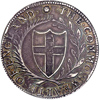 |
Great Britain. Commonwealth (1649-60) silver Crown, 1654. S-3214. ESC-7, also rated R3, "extremely rare." The Cheshire collector liked these, enjoyed the rarity of the better dates, and bought the nicest examples of each he could locate in a search that lasted about two decades. This coin is more typical of the pieces seen, its surfaces not quite so reflective or clean as on the 1652/1 piece. It was also struck from slightly buckled dies. The flan is unusually round and the strike is exceptionally clean, without the typical doubled letters so frequently seen, even on the nicest coins. Dies only slightly rotated. Dark gray surfaces. Most pleasing! Found at a shop in the north of England, therefore without pedigree, but obviously kept with unusual care. NGC graded AU-53.
Estimated Value $5,000 - 6,000.
The Cheshire Collection.
View details and enlarged photos
| Realized
$4,600 |
Lot 2172 |
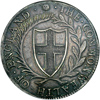 |
Great Britain. Commonwealth (1649-60) silver Crown, 1652/1. S-3214. ESC-5 ("very large 2 of date over 1" and given a rarity rating of R3 in the ESC method, thus called "extremely rare" as a variant). A beautiful example of this massive crown with lovely, reflective, old-time gray surfaces, full bold legends and date, jumbo rims, and very little double-striking. The dies were also aligned or rotated at a 45-degree variance from the norm. Stunning for a Commonwealth crown, about as nice as they come, and a rare overdate as well! NGC graded AU-55.
Estimated Value $5,000 - 5,500.
The Cheshire Collection.
View details and enlarged photos
| Realized
$5,750 |
Lot 2173 |
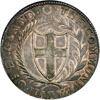 |
Great Britain. Commonwealth (1649-60) silver Crown, 1656/4. S-3214. ESC-9 (curiously, rated only "scarce"). Purchased for its eye-appeal and as the final date of its design type; in fact, struck just as the coming Cromwell crowns were in preparation (the Protector's coins were authorized in 1655, Thomas Simon set to work on them shortly after and produced the prototypes in 1656, and the portraiture coinages dated 1658 began in 1657). Thus this piece should be viewed as the last of its kind and interestingly set at this date in history. Light gray toning with silvery luster beneath, a hint of gold toning, the strike typical as are the rims and surfaces, which show die-porosity (makes sense for an overdate). Full flan with almost complete outer beaded circle on the rims. Dies rotated about 45 degrees out of normal alignment. Extremely rare state of preservation, showing original luster! NGC graded AU-55.
Estimated Value $5,000 - 5,500.
The Cheshire Collection.
View details and enlarged photos
| Realized
$5,175 |
Lot 2174 |
 |
Great Britain. Shilling, 1656. S.3217; ESC-995. The Commonwealth, 1649-1660. Mintmark, Sun. Pleasant grey and blue tone. Exceptional flan, almost perfectly round, no cracks or flaws worth mentioning, delightful impression of the dies on both sides. British bidders should consider this "mysterious MS61" to be a really nice, Good EF specimen. Worth a bid far in excess of the £300 Spink places on a VF coin of this date. To figure a sensible bid, consider this: if the coin is worth about $600 in VF, but the VF price of £300 is almost triple the Fine price of £135 (in the Spink guide book), what should a super-nice EF be worth? Three times VF price? More? Only the bidding will decide, but once sold this coin will be very difficult to replace with an equally nice example! We think our estimate is conservative, especially in light of how hot nice hammered coins are in the UK market. NGC graded MS-61.
Estimated Value $1,000 - 1,250.
The Cheshire Collection.
View details and enlarged photos
| Realized
$776 |
Lot 2175 |
 |
Great Britain. Pattern silver Sixpence by Blondeau (and Simon), 1651. Commonwealth of England. ESC-1498, plain edge. Struck in a screw press. R2, very rare. Peter (or Pierre) Blondeau, Forrer tells us, was another in a line of French engravers who invented better minting equipment. He came to England in September 1649 at the request of Parliament and made a small number of patterns on his equipment, from dies cut by the great Thomas Simon. After the Civil War ended, Charles II brought him back to England to assist in the new coinage for the Restoration. Forrer says that "much jealousy" was shown towards him when he first arrived, in 1649, and British coiners at the mint produced some patterns by David Ramage in order to show that foreign assistance was not needed. "Though these pieces were very inferior in neatness of execution to those of Blondeau, the opposition was successful and he left the kingdom," notes Forrer. It took a war, and several years, for the Royal Mint to acknowledge Blondeau's accomplishment, and invite his return. His special coins of 1651 (which include a tiny number of halfcrowns, shillings and sixpence, as here) are a great testament to his courage and talents, and are all that remain of his work for the Commonwealth. This wonderful specimen is a gem of its issue, especially sharp and free of defects, having a lovely, ancient-gray tone enhanced by delicate iridescence. It is truly exquisite. Its owner believes it to be the finest known Blondeau sixpence, and a work of high Renaissance art! NGC graded MS-64.
Estimated Value $4,500 - 5,250.
The Cheshire Collection.
View details and enlarged photos
| Realized
$4,255 |
Lot 2176 |
 |
Great Britain. Broad, or 20 shillings gold, 1656. Oliver Cromwell. S-3225. Fr-273. WR-39. Reeded edge. Designed by Thomas Simon. Reverse features a finely engraved Shield of the Protectorate. A fascinating denomination which looks both backwards in time to its origin (same value as the gold Pound of Elizabeth) and forward to the coming centuries (for it is in effect the very first Guinea, though technically valued at one shilling less). Its appearance introduced a new style of gold coin to England, a gorgeously engraved, smartly minted, fully round and technically superb presentation of wealth. Cromwell never allowed himself to be called or crowned King, and his coins broke with an ancient tradition of having each monarch look in a direction opposite to that shown on the previous ruler's coinage. Charles I was always shown looking left. Cromwell faced the same direction. It was a subtle defiance but also a way of saying he was not a king. However, his portrait was certainly regal, and in fact he looks more a Roman emperor than a "mere" English king. His Gold Broad is one of his rarest coins, surely his most impressive in gold. It rates R2 overall, Very Rare, but that is merely Wilson & Rasmussen's summary of the coin as a type. Truth be told, most are not very attractive, most show a fair bit of abuse (scratches, marks, cleaning), some of it probably intentional after Cromwell fell from glory. This delightful specimen is such a happy example! It's highly prooflike, gleaming with luster and virtually as made, and is adorned by a most fetching old-gold reddish toning in its lettering. Few others can compare to this excellent specimen, one of the finest known. Only the Terner #1 specimen was finer, in the cataloguer's experience. NGC graded MS-64.
Estimated Value $20,000 - 22,500.
The Cheshire Collection.
View details and enlarged photos
| Realized
$27,600 |
Lot 2177 |
 |
Great Britain. Silver Crown by Simon, 1658/7. Oliver Cromwell, the Lord Protector. S-3226. ESC-10. Edge not viewable in the slab. A classic in super-nice condition! A really choice example. Reflective surfaces beneath dark bluish gray toning, with hues of gold iridescence. Some small marks and faint hairlines in the color. Struck from buckled dies, which produced the extensive die-break that runs entirely across the base of Cromwell's throat and through the top of the drapery. The overdate is crisp, sharp as can be. Legends and design are well struck but lack the tiny detail that can be seen in the next specimen, a Proof made 80 years later by Tanner. Compare the two pieces and you will discover the artistry that made Thomas Simon, who engraved the dies for this coin, world famous. The very first milled English crown, and a joy to behold in every way, but particularly for its tone and prooflike surfaces. The consignor believes this to be ex Beaumont. NGC graded Proof 64.
Estimated Value $10,000 - 12,500.
The Cheshire Collection.
View details and enlarged photos
| Realized
$9,775 |
Lot 2178 |
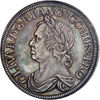 |
Great Britain. Silver Crown by Tanner, 1658. Famed copy of the Cromwell portrait crown, by J.S. Tanner (1706-75), engraver at the Royal Mint under the reign of George II. S-3226B. ESC-13. Edge not viewable in the slab but the consignor notes there is no die flaw on its edge. Much rarer than the Simon crown (which is "scarce" while the Tanner coin is rated R4 by ESC, extremely rare, just 11 to 20 known). Prospective bidders should take this rare opportunity to compare the two 1658 crowns in this auction. Simon's engraving on the original shows a brooding, unpleasant pseudo-king, somehow evincing his war-like disposition in the aspect of his jowls and the "anger" in his eye. This was the work of a supreme artist, and Cromwell in life was Simon's model. By contrast, the wonderful "copy" by Johann Sigismund Tanner, a marvelously talented engraver in his own right but the product of a later century, shows Cromwell as a figure along the order of that of a Roman emperor. There is no mood in his face now. But rather, the engraving is altered to give a finer quality, calmer and statuesque. It is not lesser; it is different. What Tanner in fact did was locate the puncheons used by Simon, re-engrave them, and create new dies that almost duplicated Simon's. Almost. Certainly it was by intention, not error, that he made the date a sharp, singular 1658, not 8/7. Certainly he paid homage to the great Thomas Simon by respecting the minute differences in engraving of the earlier piece. At the same time, Tanner imparted intimate detail in Cromwell's hair (but left his laurels less pronounced) and gave an extraordinary clarity to the details of the reverse shield. Tanner also substituted rounded, slightly more even beading to the rims. The Cheshire Collection specimen of this great rarity is one of the very finest extant, a gorgeous coin with ancient gray toning, almost identical in appearance to the Simon crown which is its complement. NGC graded Proof 64.
Estimated Value $16,000 - 20,000.
The Cheshire Collection.
View details and enlarged photos
| Realized
$14,375 |
Lot 2179 |
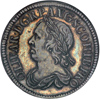 |
Great Britain. "Pattern" silver Shilling, "1658." A very rare example of the copy by J.S. Tanner of Thomas Simon's original 1658 coinage. Die-alignment opposite that used on the original Simon coins. Tanner's piece was made about 1738 within the Royal Mint and has long been accepted as a highly collectible specimen relating to the Cromwell era. Type of S-3228. ESC-1006a, on thick flan, rated R6: excessively rare. Also called the Dutch Copy, but this is misleading, an old error frequently repeated. Forrer tells us that Johann Sigismund Tanner emigrated from Saxe-Gotha to England in 1728, and that his engraving skills early demonstrated on snuff-boxes and the flint-locks of guns came to the attention of the Royal Mint's master, John Conduit, who employed him as assistant to master John Croker; on Crocker's death in 1741, Tanner advanced to post of Chief Engraver, Royal Mint. Evidently at some point he discovered the old, rusted dies used by Simon to produce Cromwell's coins back in 1656-58. Many of the original coins had been defaced or destroyed by those who detested Cromwell and his forbidding reign. Of particular rarity was the original sixpence; it is possible that Tanner wished to offer copies to collectors as a result of pressure, or requests for them, which seems sensible but cannot be proven. Certainly almost the only way a collector today may own a Cromwell sixpence is by buying one of Tanner's pieces. What is known is that Tanner used Simon's punches, tidied them up a bit, made tiny errors (perhaps intentional) in the legends, and produced inside the Royal Mint beautiful copies of the Simon coins, probably releasing the first of them in 1738. All were made in extremely limited numbers. Henfrey says: "The dies of this shilling still remain in the royal Mint, as well as Simon's original punches for the head and arms. It is therefore our opinion that Tanner made the dies of this piece, using Simon's punches, but engraving the legends himself." The present specimen, an extra-thick shilling, is among the rarest of his products; it is sometimes called the "Dutch two-shilling piece" or florin, but again those are misnomers. Henfrey states that all the shillings are in silver and generally have plain edges, but a few have milled or reeded edges; he also says the heavy pieces are sometimes called "pattern two-shilling pieces." The Cheshire collector notes that only 3 or 4 examples are known of this, making it the rarest of the Tanner/Cromwell coins. Henfrey knew of one in the British Museum, another in the Hunterian Museum in Glasgow, and perhaps three in private hands, including the awesome Brice cabinet. All of the extra-thick pieces evidently have plain edges. This wonderful specimen is deeply toned and, says its owner, far finer than the Norweb specimen, sold in 1985 at auction (said to have had a test cut on its edge and been lacquered). A highly important coin, seldom available, and possibly the finest of just a few known. The cataloguer suspects it's the Brice coin, because of some tiny red wax dots, which were how Brice marked his coins for posterity; they are removable, of course, but that would be a crime. NGC graded Proof 64.
Estimated Value $10,000 - 12,500.
The Cheshire Collection.
View details and enlarged photos
| Unsold |
Lot 2180 |
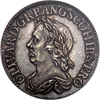 |
Great Britain. Shilling, 1658. S.3228; ESC-1005. Oliver Cromwell. Laureate draped bust left. Reverse: Crowned shield. Deeply toned, prooflike and well struck. A sharper than normal strike with great detail of execution of the dies. Cats £1,850 in EF (about $3,600), and should certainly be worth that much as it's heads above most pieces seen. NGC graded MS-63.
Estimated Value $3,500 - 4,000.
The Cheshire Collection.
View details and enlarged photos
| Realized
$3,360 |
|
|